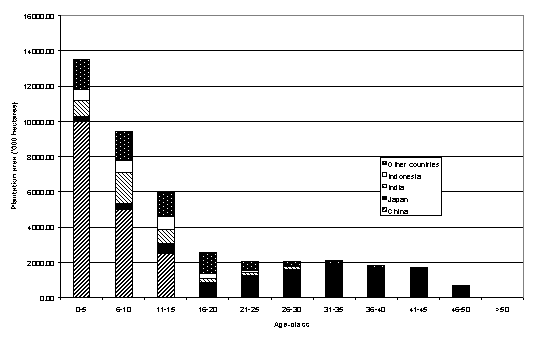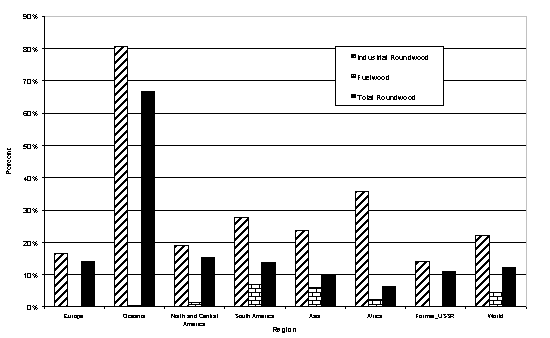INFORMATION AND ANALYSIS FOR SUSTAINABLE FOREST MANAGEMENT: LINKING NATIONAL AND INTERNATIONAL EFFORTS IN SOUTH AND SOUTHEAST ASIA
Chris Brown, Forestry Sector Outlook studies specialist,
FAO Regional Office for Asia and the Pacific
Over the past several years FAO has intensified its efforts to quantify the potential extent of future wood supplies from forest plantations. Considerable effort has been applied to collating and refining data on forest plantation areas, species, age-classes and yields. Nonetheless, the ideal of global plantation woodflow modelling being done with real precision remains elusive.
There have been three principal efforts to collect forest plantation data, by FAO:
through the Forest Resource Assessment
through the Global Fibre Supply Model
through a specialised plantation study as part of the Global Forest Products Outlook Study
Plantations and the forest resource assessment
The assessment of the forest plantation resource is an integral component of the Global Forest Resources Assessment 2000 Programme of the FAO. The FRA 2000 plans to produce a separate volume on the forest plantations for the developing countries. With the start of this work on 23 August 1999, a standard format "output table" for presenting the plantation data of each country was designed and later finalised. The main feature of the output table is breaking down of the total plantation area by the main species/ species group, and breaking down of species area further by purpose and ownership.
Despite the relative simplicity of the data sought, compiling a report for all developing countries has been a mammoth effort.
Plantations and the Global Fibre Supply Model
The Global Fibre Supply Model (which will be described by the following presenter) also sought plantation data as a means of estimating potential wood and fibre supplies. In the event, due to data scarcity and difficulties in standardising data, only a very simple plantation model was built.
Plantations and the Global Forest Products Outlook Study
In addition to providing the modelling capability of the GFSM, FAO has also sought to conduct its own more detailed studies to refine predictions of wood supply from global plantations. These coalesced into the GFPOS Thematic study on plantations. At the centre of the GFPOS effort was an attempt to construct representative national plantation age-class distributions. Efforts were also made to improve species yield data, national mortality rates, and to make assessments of likely species rotations in individual countries. The data gathered was used to model estimates of current plantation wood production as well as future rates based on new planting scenarios.
The following two graphs present some of the results of the data gathering and modelling.
 Figure 1. Derived industrial plantation age-class structure by country - Asia 1995
Figure 1. Derived industrial plantation age-class structure by country - Asia 1995
This first graph shows the derived age-class description for Asian plantations. An examination of the Figure shows that the majority of Asia's industrial plantations are aged less than 15 years. This is largely due to a very rapid acceleration in plantation establishment in China, and due to the short rotations generally used in that country. Japanese plantations predominate in the older age-classes.
The second graph shows an estimate of current industrial and non-industrial plantation harvests as a percentage of the total harvest of natural forest and plantation-grown industrial roundwood, fuelwood and total roundwood. A number of interesting features are evident from the graph. The "bottom-line" shows that current plantation production could6 be supplying around 12 percent of the world's total roundwood harvest. The harvest from plantations designated "industrial" constitutes, however, a far greater proportion of reported industrial roundwood production, than does the proportion of non-industrial plantation relative to fuelwood production. Industrial plantations are estimated to contribute 22.2 percent of global industrial roundwood production, compared with non-industrial plantations' 4.4 percent share of fuelwood production.
Figure 2. Estimated plantation wood supply as percent of total roundwood harvest - 1995

Plantation data weaknesses
The overall experience in each of these three exercises is that plantation data is weak in most countries. Very few countries carry out a separate plantation inventory, and often national data vary wildly across time. Little account is made for plantation mortality rates, and it is difficult to ascertain whether planting rates include areas of plantations that have already been harvested.
Pilot study options
There are many options for improving plantation data. The discussions we have had to date have thrown up a number of options for pilot studies, including:
Translating nursery production to new plantation establishment
Measuring mortality rates in forest plantations
Developing a rapid appraisal system for national plantation resources
Surveying management regimes in plantation forests
Predicting plantation forest wood flows
Measuring biological diversity in forest plantations
On this point I'll now hand back to the Chairman to open up discussions.
Thank you
6 That is, the global plantation age-class structure under the assumed national harvesting profiles would yield 417 million cubic metres of plantation grown roundwood in 1995 (refer Appendix 2).